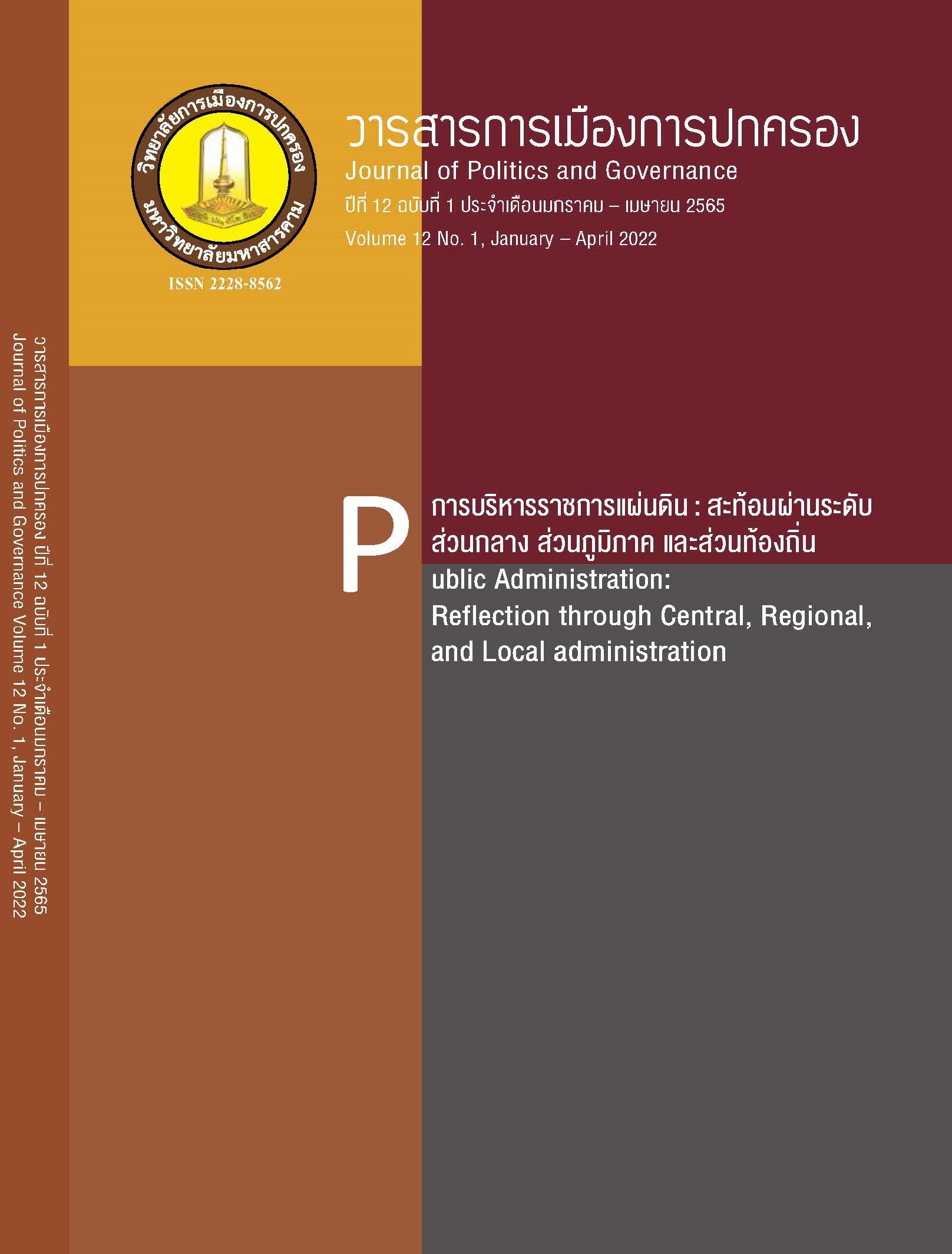หลักแห่งความเป็นภัยอันตรายแก่ผู้อื่นของจอห์น สจ๊วต มิลล์ ในฐานะแนวทางการป้องกันทรราชของเสียงข้างมากในเสรีนิยมประชาธิปไตย
Main Article Content
บทคัดย่อ
บทความชิ้นนี้ได้นำเสนอความเข้าใจเกี่ยวกับหลักแห่งความเป็นภัยอันตรายแก่ผู้อื่น ของ John Stuart Mill ในฐานะแนวทางการป้องกันทรราชของเสียงข้างมากในเสรีนิยมประชาธิปไตย กล่าวคือ งานศึกษาชั้นนี้ใช้วิธีการศึกษาแบบปรัชญาการเมืองผ่านการตีความวิเคราะห์ตัวบทอย่างละเอียด ผลการศึกษาพบว่า Mill หวาดกลัวทรราชของเสียงข้างมาก และถือว่ามันเป็นความชั่วร้ายประการหนึ่งในเสรีนิยมประชาธิปไตย. ดังนั้น เขาจึงเสนอว่า, มนุษย์สามารถกำหนดชีวิตตนเองได้, และความสุขที่มากที่สุดของคนจำนวนมากที่สุดย่อมมาจากการที่ปัจเจกบุคคลมีเสรีภาพ. ดังนั้น ปัจเจกบุคคลที่เป็นผู้ใหญ่แล้ว ควรมีเสรีภาพในการกระทำตามที่ตนปรารถนา ตราบเท่าที่การกระทำนั้นไม่เป็นภัยอันตรายแก่ผู้อื่น, กล่าวคือ, เหตุผลเดียวที่ชอบธรรมพอที่จะแทรกแซงเสรีภาพของปัจเจกบุคคลได้ คือ การป้องกันไม่ให้เกิดภัยอันตรายแก่ผู้อื่น, นี่คือหลัก แห่งความเป็นภัยอันตรายของ Mill, และเป็นแนวทางการป้องกันทรราชของเสียงข้างมากในเสรีนิยมประชาธิปไตยได้. งานชิ้นสำคัญของ Mill เรื่องนี้ คือ งานเขียนของเขาที่ชื่อ ว่าด้วยเสรีภาพ ซึ่งตีพิมพ์ในปี ค.ศ. 1859 และ ข้อพิจารณาว่าด้วยการปกครองแบบมีตัวแทน ซึ่งตีพิมพ์ในปี ค.ศ. 1861
Article Details
เอกสารอ้างอิง
พิศาล มุกดารัศมี. (2560). ทรราช: ในฐานะศาสตร์และระบอบการปกครอง. วารสารรัฐศาสตร์ มหาวิทยาลัยสุโขทัยธรรมาธิราช, 1(2), กรกฎาคม-ธันวาคม 2560.
ศักดิ์สิทธิ์ ฆารเลิศ. (2561). พลเมืองเสรีประชาธิปไตย. กรุงเทพฯ: โรงพิมพ์มหาวิทยาลัยธรรมศาสตร์.
______. (2562). ความสัมพันธ์ระหว่างหลักแห่งอรรถประโยชน์ของจอห์น สจ๊วต มิลล์ กับประชาธิปไตย. รายงานการประชุม การประชุมวิชาการระดับชาติ ด้านการบริหารกิจการสาธารณะยุคดิจิทัล ครั้งที่ 5 การบริหารกิจการสาธารณะยุคดิจิทัล: กฎ หมาย ความเป็นธรรม และการกลับคืนสู่ประชาธิปไตย. ขอนแก่น: วิทยาลัยการปกครองท้องถิ่น มหาวิทยาลัยขอนแก่น.
_____. (2562). แนวคิดเรื่องทรราชของเสียงข้างมากในทัศนะของจอห์น สจ๊วต มิลล์. รายงานการประชุม การประชุมวิชาการบัณฑิตศึกษาระดับชาติ ครั้งที่ 15. เชียงใหม่: สมาคมรัฐศาสตร์แห่งมหาวิทยาลัยเกษตรศาสตร์.
ศักดิ์สิทธิ์ ฆารเลิศ. (2563). ชีวิต การศึกษา และผลงานของจอห์น สจ๊วต มิลล์. วารสารสังคมศาสตร์ คณะนิติรัฐศาสตร์ มหาวิทยาลัยราชภัฏร้อยเอ็ด, 4(1), มกราคม – มิถุนายน 2563.
สมบัติ จันทรวงศ์. (2527). ตัวบท (The text) กับการเรียนการสอนวิชาปรัชญาการเมือง. กรุงเทพฯ: ศูนย์วิจัยคณะรัฐศาสตร์ มหาวิทยาลัยธรรมศาสตร์.
Bartels, P. S., & Hamot, G. E. (2016). Majority Tyranny. In S. Schechter, T. S. Vontz, T. A. Birkland, M. A. Graber, & J. J. Patrick (Eds.), American Governance, 3 (pp.235-237). Farmington Hills, MI: Macmillan Reference USA.
Beetham, David and Boyle, Kevin. (2009). Introducing democracy: 80 questions and answers. Paris: UNESCO Publishing.
Benn, S. I. (2006). Democracy. In D. M. Borchert (Ed.), Encyclopedia of Philosophy, 2(2), 699-703. Detroit, MI: Macmillan Reference USA.
Bobbio, Norberto. (2005). Liberalism and democracy. Martin Ryle. & Kate Soper. London; New York: Verso.
Breiner, P. (2006). Democracy. In C. N. Tate (Ed.), Governments of the World: A Global Guide to Citizens' Rights and Responsibilities, 1 (pp.301-307). Detroit, MI: Macmillan Reference USA.
Carnagie, J. L. (2016). Classical Greek Civilization: 800–323 BCE: Politics, Law, and the Military. UXL World Eras, 3 (pp.27-57). Farmington Hills, MI: UXL.
Fontana, B. (2005). Democracy. In M. C. Horowitz (Ed.), New Dictionary of the History of Ideas, 2 (pp.551-556). Detroit, MI: Charles Scribner's Sons.
Gadamer, Hans-Georg. (1988). Truth and Method. In Joel. Weinsheimer and Donald G. Marshall (Eds.), New York: Continuum.
_____. (1976). Philosophical Hermeneutics. In David E. Linge (Ed.), Berkeley: University of California Press.
Moulton, C. (1998). Democracy Greek. Ancient Greece and Rome: An Encyclopedia for Students, 2, 2-3. New York, NY: Charles Scribner's Sons.
_____. (1998). Tyrants, Greek. In C. Moulton (Ed.). Ancient Greece and Rome: An Encyclopedia for Students, 4 (pp.111-112). New York, NY: Charles Scribner's Sons.
Mill, John Stuart. (1991). On Liberty (1859). In john gray (Ed.), On Liberty and Other Essays (pp.1-128). Oxford New York: Oxford University Press.
Mill, John Stuart. (1991). Considerations on Representative Government (1861). In john gray (Ed.), On Liberty and Other Essays (pp. 203-467). Oxford New York: Oxford University Press.
Plamenatz, John. (1963). Introduction. In Man and society Volume one: a critical examination of some important social and political theories from Machiavelli to Marx (pp. ix-xxii). London: Longman.
Salmon, J. H. M. (2004). Tyranny, Theory of. In J. Dewald (Ed.), Europe, 1450 to 1789: Encyclopedia of the Early Modern World, 6 (pp. 84-87). New York, NY: Charles Scribner's Sons.
Schall, J. V. (2003). Tyranny. New Catholic Encyclopedia, 2(14), 257. Detroit, MI: Gale.
Selesky, H. E. (2006). Taxation without Representation is Tyranny. In H. E. Selesky (Ed.), Encyclopedia of the American Revolution: Library of Military History, 2 (p. 1143). Detroit, MI: Charles Scribner's Sons.
W. A. Darity, Jr. (2008). Tyranny of the Majority. International Encyclopedia of the Social Sciences, 2(8), 478-479. Detroit, MI: Macmillan Reference USA.
Watson, B. C. S. (2006). Liberal Democracy. In C. N. Tate (Ed.), Governments of the World: A Global Guide to Citizens' Rights and Responsibilities, 3, (pp. 84-90). Detroit, MI: Macmillan Reference USA.

